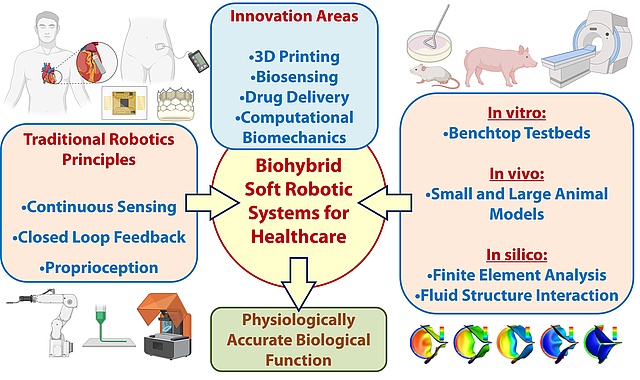Soft Robotic Medical Devices and Implants

Our interdisciplinary research group addresses the unmet need for high fidelity platforms for the design and testing of medical devices. We realize this vision by combining principles from traditional robotics, such as continuous sensing and closed-loop feedback mechanisms, with the bioinspired approaches of soft robotics to eventually reach towards mimicking physiologically accurate biological function. We incorporate in vitro, in vivo, and in silico research, using our experience in soft robotics, 3D printing, biosensing, small and large animal models, computational biomechanics, and drug delivery.
Why soft robotics?
In contrast to rigid-bodied robots built from metals, ceramics and hard plastics, soft robots are made of soft and/or compliant materials, making them inherently safe when working in close contact with humans. The growing field of soft robotics provides an ideal opportunity for the development of implantable devices and biomimetic simulation testbeds due to the constituent materials possessing mechanical properties comparable to that of biological tissue. Furthermore, soft robotic actuators are excellent candidates to replicate the mechanics of dynamic organ systems in our body, such as the heart, lungs and diaphragm, peristaltic motion in the esophagus, to name just a few. Soft robotic devices are pushing the boundaries of robotics in accomplishing tasks that are out of the reach of traditional rigid-body systems.
Our recent work has utilized soft robotic technology to build both benchtop and in vivo models of cardiovascular disease. We have also developed novel implantable soft robotic drug delivery devices with potential applications in the treatment of type 1 diabetes. These platforms can be harnessed to simulate disease progression, enabling more accurate and personalized treatment strategies.
Our approach leverages both engineered materials and biological cues, bridging the gap between mechanical devices and living tissue. It represents a convergence of robotics, biomedical engineering, and computational modeling, aiming to redefine the interface between machines and the human body for next-generation medical therapies.
For more information visit: https://www.dgoswami.org/
|
Debkalpa Goswami
|
 |
| debkalpa.goswami@tugraz.at | |
|
https://www.linkedin.com/in/debkalpagoswami/?originalSubdomain=at
|
|
